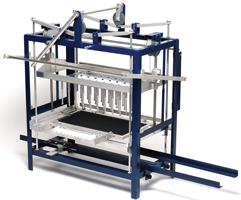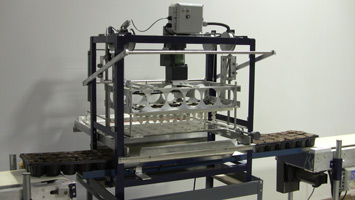5/29/2014
Big Efficiency for Small Growers
Jennifer Duffield White
Every greenhouse grower has the same basic responsibility—plant, grow, water and sell. But just because you’re a small grower and can do it by hand doesn’t mean it’s the best way for your business. While you can’t invest hundreds of thousands of dollars into automation, don’t let the word “automate” preclude you from seeking out improvements. There are plenty of affordable efficiency solutions that can save labor, energy and money.
“It’s important that small growers find ways to become more efficient in their greenhouse operations,” says AgriNomix’s Mike Herring. “Finding ways to reduce the number of ‘product touches’ is one area where properly applied solutions can result in major increases in efficiency and cost savings.”
Figuring it out
While your scale may be smaller, that does not mean that labor and energy efficiency have poor returns on investment. Start by taking a good look at your labor and what requires the greatest amount of time in your operation—transplanting, watering, moving plants, shipping and so on. What can you improve? What will make the biggest contribution to your business?
A simple calculation from John Bartok at the University of Connecticut: If you pay $10 per hour, walking a handful of flats to the end of a 100-ft. greenhouse costs 15 cents. Shorten the trip to 10 ft. and it costs $0.02. Every time you move a tray, it costs you. (Think carts, wagons, conveyors and improved workflow to change those
numbers.)
Likewise, look at where your greenhouse may be leaking energy. Energy efficiency improvements typically require an upfront investment, but the good news is that over time they should pay for themselves in savings. Plus, you can apply for USDA Rural Energy for America Program (REAP) grants and/or loans to help offset energy efficiency improvements.
Following are a few simple suggestions.
 Irrigation
Irrigation
Most smaller growers spend a lot of time at the end of a hose. It may even be your biggest labor expense. Irrigation improvements can reduce that labor cost and also provide more accurate, uniform watering and can help with water conservation. From inexpensive drip tape to more permanent irrigation systems, you have lots of options. Further automate that irrigation by teaming up with environmental control companies such as Wadsworth and Argus, who also have systems that can work for a smaller grower, allowing you to pick and choose what you automate.
Soil filler work area
Still filling your trays and pots ahead of time? Stacking them up for later? Mike notes, “This leads to unnecessary product touches, as once they are assembled and stacked, they have to be touched again to move to the production line and then placed on the line for filling.”
Solution? Upgrade your filling/planting area. A sufficient length in-feed conveyor and a work area in front of a soil filler allows you to fill trays/pots on the conveyor at the same time. “Whether the work is done manually or with automation, this process saves touches and time,” says Mike.
 Ellepot machine
Ellepot machine
If you haven’t already considered one, you might look into the fact that you can produce your own pots with the H101 Ellepot machine. While buying in stabilized media can cost a small grower $3 to $4 per tray, Blackmore Company’s David Steiner says producing your own Ellepots can cut the cost by half at least and down to a dollar per tray if you reuse the tray. “Sometimes the freight savings alone will pay for the machine in a few years,” he says.
Seeder
A good seeder can be affordable and save you lots of time. Blackmore Company touts their Turbo/Needle seeder as an affordable option for the smaller grower who wants to grow their own plugs. The Turbo/Needle seeder can sow 300+ trays per hour.
Tip: You might even be able to save a little more money by asking if they have reconditioned machines available.
 Punch ’N Gro
Punch ’N Gro
Big growers may have large, fancy, automated transplanting machines, but smaller growers have options, too. The manually run Punch ’N Gro plants your Punchable plugs (whether grown in house or bought in) in one fell swoop. The machine, which is distributed by Ball Seed, starts around $3,800. (If doing your own seeding, you can source the specialized plug trays from Blackmore.) Growers who switch from hand transplanting to this system typically see at least a 50% increase in trays transplanted per hour.
Planting line and water chamber
Sticking cuttings day after day? A multi-purpose planting line with a powered watering chamber can improve efficiency and reduce labor. AgriNomix recommends a line with two conveyors: the top conveyor delivers to each worker filled trays ready to stick and the bottom line has fold-down work stations where workers can stick cuttings. Mike says, “The top conveyor would also be designed to be lifted up and out of the way, which enables workers to fold down every other work station and use the bottom conveyor for planting.” Meanwhile, an in-line powered watering chamber uniformly waters each tray as it passes under the watering heads.
“Together, these two simple solutions bring efficiency, consistency and labor savings to the process. In fact, grower experience has shown labor savings of up to 50% following implementation of these two solutions,” says Mike.
Larger bales
Another way to reduce your product touches, says Mike, is to stop using those 3.8-cu. ft. compressed bales (or loose-filled bags). “These can eat up a lot of labor, as they require unloading, storing, moving to the production line, opening, decompressing or fluffing, and loading into the filler hopper.”
Instead, look at using 55-, 110- or 135-cu. ft. bales and a bale shaver. “The bales are easier and faster to unload, store and move,” says Mike. The bale shaver requires less labor. “Compared to handling a 55-cu. ft. bale, a 3.8-cu. ft. bale requires approximately 14 touches to 1, and 28 to 1 compared to a 110-cu. ft. bale.”
 Dibbler
Dibbler
A planting line may also benefit from the addition of a dibbler, which can offer both efficiency and improved growing conditions. Blackmore’s Dribbler with Wiper, for example, is manually operated and can speed up your planting line. It drills holes for 4-in. pots, window boxes, color bowls, hanging baskets, Ellepots and loose-fill trays. The advantage, says David, is that the planting lines go faster and plants perform better and quicker with uniform planting depth. “So quality improves and plants are ready to ship earlier.”
Energy curtains
You can quickly recover the cost of energy curtains through savings in your heating bill. That’s a no-brainer and you can even apply for a USDA REAP grant to offset some of the initial cost.
Hans van der Spek of J.C. van der Spek Greenhouse Services has noted a few new money-saving trends and details in energy curtains.
Installing multiple curtain systems, one on top of the other. “Not only do they have a greater heat savings but they also have the benefit of retracting a different fabric during the daytime depending upon the crop they grow and this can be beneficial,” says Hans.
Using roll-up curtains to divide greenhouses into two parts. It gives you the convenience to heat only half of the structure when needed and still quickly open it up when your seasonal needs change. Hans says roll-up curtains are also being installed on the interior of the exterior walls of greenhouses to provide additional heat retention.
Perimeter seals. Hans says, “I think it is very important that growers look out and ask for perimeter seals when they have new greenhouse curtains installed. This is very important in making the system efficient and complete against heat loss.”
Maintenance. This goes for most things in your greenhouse. Investing in regular maintenance saves money in the long run. “We recommend a scheduled maintenance plan every six to twelve months,” Hans says.
Unit heaters
While unit heaters are often a good, cheap way to heat smaller growing spaces, there are many ways to make them more or less efficient. For one, a stainless steel heat exchanger has a longer lifespan in a humid environment. Scott Sanford, University of Wisconsin-Madison, also writes that the heat distribution location can have a dramatic impact on total energy usage and plant growth. Consider growing on a heated floor or bench (installing bench skirts to keep the heat under the bench) or using poly tube overhead and horizontal airflow fans to keep constant temps for the plants.
Take note that there is a Propane Farm Incentive Program (
www.agpropane.com/incentive) where you can receive up to $2,000 toward the purchase of a propane unit heater, such as the Therma Grow, if it’s part of an entire system installation. (You’ll have to agree to record and report usage data for one growing season.) Mark Leitman, PERC director of business development and marketing for the ag market for the Propane Farm Incentive program, says they’ve worked with several growers over the past year who’ve reduced overall fuel consumption with a propane-powered LB White Therma Grow Greenhouse Heater.
The bad news is that none of these things are free. The good news, however, is that if you do your homework and make the right choices for your greenhouse, they can be investments that pay for themselves over time and reduce your overall operating costs. And that is smart business.
GT